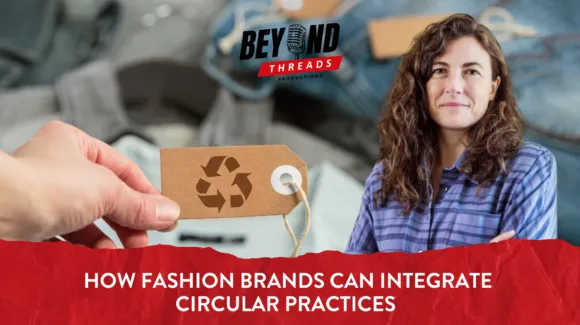How can digital IDs enable a more sustainable fashion industry?
Digital IDs provide customers with detailed information on how to care for and repair their garments, the origin of the raw materials used, the conditions under which they were produced and the authenticity of the items they have purchased. By providing greater transparency and insight into garment supply chains, digital IDs can help minimise unsustainable practices in the fashion industry and catalyse circular business models.
In my last blog, we began to explore how the use of data collection and consolidation can help accelerate the transition to a circular economy for fashion and textiles. Today, we’ll look at some of the ways that fashion brands are already harnessing the power of data to facilitate a more sustainable fashion industry in Europe and beyond.
A high-end example of how digital IDs can drive circularity is luxury brand Chloé’s recent ‘Chloé Vertical’ initiative. The brand created digital IDs for many of the items in its Spring/Summer 2023 collection. This allowed owners of Chloé bags, shoes and ready-to-wear to access information about their purchases via a QR code. The data covers the origin of the raw materials to the factory where the finished articles were produced, offering full transparency.
Most importantly for us, however, the digital IDs also contain detailed care and repair information. This helps to ensure that products remain in the best possible condition for as long as possible. A digital certificate of authenticity is also included, making it much easier to resell goods. To facilitate this circular business model, Chloé has partnered with Vestiaire Collective, the luxury second-hand fashion platform, to make reselling its products a breeze. Owners simply scan the QR code, and the authenticated item can be resold. This way, Chloé’s digital ID system enables two circular business models in one: not bad for a simple QR code!
Other luxury brands are taking similar steps, including Burberry, Armani, Pangaia, and many more. In addition, LVMH’s Aura blockchain consortium aims to push transparency in luxury to new levels. These efforts represent positive steps forward for traceability and transparency in fashion. However, the fact that these are all high-end brands does raise the question of cost: is this level of traceability only feasible for the most exclusive products?
How are digital IDs unlocking circularity across the fashion industry?
Happily, a brand’s price positioning is becoming less and less of a barrier to entering the digital ID space. For instance, H&M, Target, C&A Foundation and PVH Corp partnered with Microsoft and EON in 2020 to create CircularID. Similar to Chloé Vertical, this digital ID system will contain a range of information about individual products, including details on authenticity, materials and their origins, the original style specifications and recycling instructions.
This information will stay with goods throughout their lifetime, and a variety of technologies can be used to access it, including RFID, NFC, QR codes and UPC barcodes. The renewal professionals can then use this information to ensure that clothes and other products get the best renewal treatment possible. And customers get full peace of mind.
The original goal of the CircularID project was to connect 400 million products to EON’s platform via digital IDs by 2025. But with more partners coming on board, and the resale market showing strong growth, this could be just the beginning. Creating an industry-wide foundation for a connected and circular economy is becoming much more achievable. And soon, thanks to increasing regulatory pressure, embracing circular business models may no longer be optional but mandatory.
What legislation exists on digital IDs for fashion and textile products?
It’s not just private companies that are leading the push for more unified product ID solutions. As part of its Ecodesign for sustainable products regulation (ESPR), the European Commission (EC) is planning to introduce mandatory digital product passports (DPPs) for a range of high-priority goods. And at the top of the list are fashion and textile products.
The passports would likely include a range of information similar to that of CircularID, including product specifications, certificates of authenticity, and carbon footprint ratings. Eventually, this data would be accessible to circular partners such as The Renewal Workshop. This would help to streamline our operations: as soon as a returned garment came in, we could simply scan it and instantly get information on how to repair or renew it.
It also allows us to track the lifetime impact of garments more effectively, revealing how much water and energy they consume during their lifetime – and the levels of greenhouse gases emitted at every stage of their life cycle. This more accurate tracking means that manufacturers can better optimise sourcing and production processes.
Digital IDs will also be important for optimising textile recycling. For instance, digital IDs would likely show information about any substances of concern that garments may contain. Recyclers could then use this information to help them avoid contaminating their recycling streams. It’s all about ensuring that products and materials stay in circulation for longer.
Although the exact details of the product passport scheme are still being ironed out, there are potential frameworks in the pipeline. For instance, CIRPASS is a consortium of companies working to make a standardised EU-wide system for digital IDs a reality. CIRPASS brings together over 30 companies, NGOs and research institutions. And they aim to develop concrete guidelines for implementing digital IDs in the fashion and lifestyle value chain.
The CIRPASS consortium’s proposed strategy is expected to be adopted by the EC in 2024. This would mean that DPPs become mandatory for all textile products sold in the EU by 2030. So, what effect will a system like this have on how fashion and textile brands create products? Check back soon for part three of this series, where we explore the potential impacts.
Want to find out more about our circular fashion solutions?
Why not talk to one of Bleckmann’s circular fashion experts today? We’d be happy to discuss how your brand can make the most of circular business models.
Check back soon for part three, were we’ll be discussing how the widespread use of digital product IDs could impact the fashion industry.













